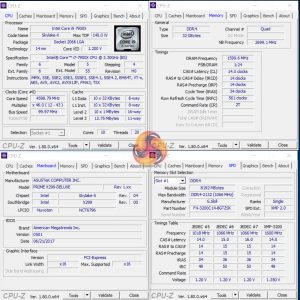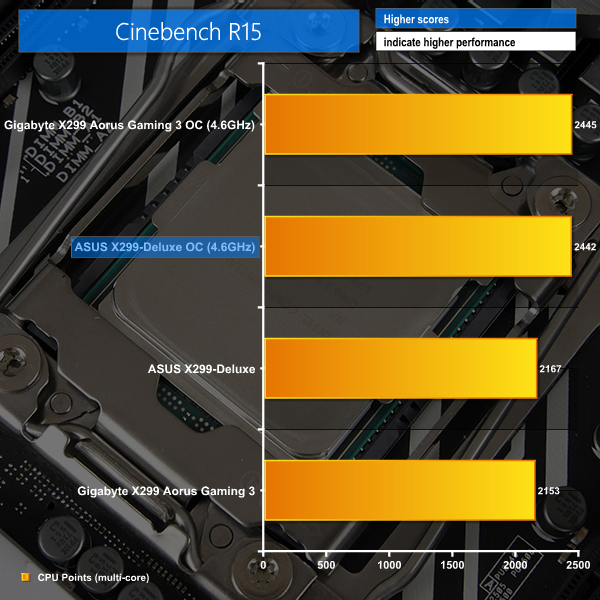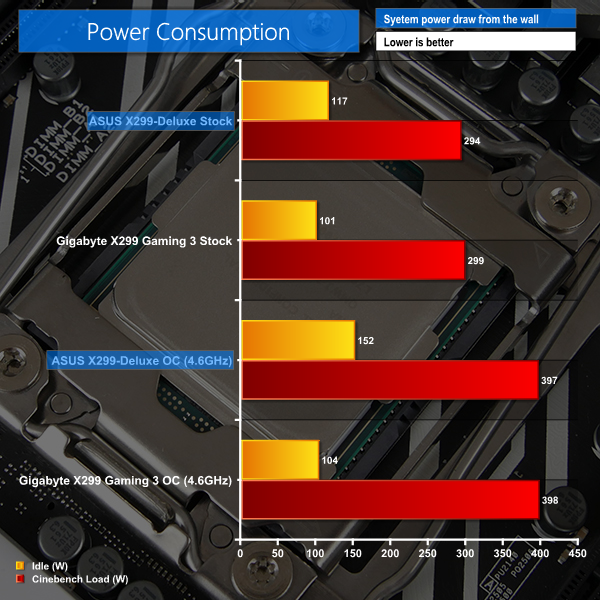Manual CPU Overclocking:
To test the ASUS Prime X299-Deluxe motherboard’s CPU overclocking potential, we aim to set the CPU voltage close to 1.20V. CPU VCore is set to 1.20V.
We maintained the DRAM frequency at 3200MHz to take its stability out of the overclocking equation.
Overclocking was relatively straightforward thanks to ASUS' well-designed UEFI. The LLC settings did not make much sense so a trial-and-error approach had to be used. Voltage accuracy was very good, according to CPU-Z, though there was no way to validate this reading without onboard voltage check points.
As is already known, it is difficult to cool a Skylake-X i9-7900X CPU overclocked with 1.2V even using a 360mm AIO. CPU temperatures were high but reported VRM temperatures inside our Corsair Air 540 test chassis remained well below 80°C even under sustained AIDA64 stress testing. It is likely that you will need a higher core count CPU or a de-lidded chip (or Prime95 AVX) to start stressing the MOSFET heatsink beyond reasonable temperature levels.
Overclocked Performance
As a performance comparison, we have included the results from the Gigabyte X299 Aorus Gaming 3. The maximum overclocked configuration achieved with each board was a 4600MHz (46 x 100MHz) processor frequency whilst using 3200MHz CL14 memory.
A strong performance increase was obtained by overclocking.
Power
We leave the system to idle on the Windows 10 desktop for 5 minutes before taking a reading. For CPU load results we run Cinebench multi-core and take a reading. The power consumption of our entire test system (at the wall) is shown in the chart.
Idle power consumption from the ASUS motherboard is high as the PWM controller looks to be keeping voltage levels elevated even under lower load conditions. A greater number of add-on controllers also contributes to the ASUS board's increased low-load power draw.
However, the strong 8-phase solution proves its efficiency under higher load scenarios, albeit by a few Watts compared to the Gigabyte offering.
 KitGuru KitGuru.net – Tech News | Hardware News | Hardware Reviews | IOS | Mobile | Gaming | Graphics Cards
KitGuru KitGuru.net – Tech News | Hardware News | Hardware Reviews | IOS | Mobile | Gaming | Graphics Cards






Awesome review…..but my heart leapt when I saw the Air 540, I still mourn the day I sold it, I can still see it leaving my street in the back of the guys car. Goodbye little ‘Sugercube’ I still miss you.
PCIE slot placement has always been a thing for ASUS or at least on every board I’ve ever owned, I remember not being able to SLI because a gpu fouled all of the headers on the bottom of the mobo a few years back. Did you try the 5 way optimisation ; ) I’m just curious knowing how generous it can be with voltages, you will get some customers who click it and just trust it knows what its doing.
“Positioned close to the 24-pin is one of the board’s two M.2 connectors. This PCIe 3.0 x4-only slot is mounted to allow for vertical orientation of an installed M.2 device. A support bracket and screws are included. Vertical mounting is good for putting the device in a direct airflow path, while also minimising the footprint taken up on the board PCB”. – Yup and is all the worst way to put one and will get snapped by any wandering hands of if some one mounts a DVD rom’s that are to log for the slot (yes ppl still use DVD roms).